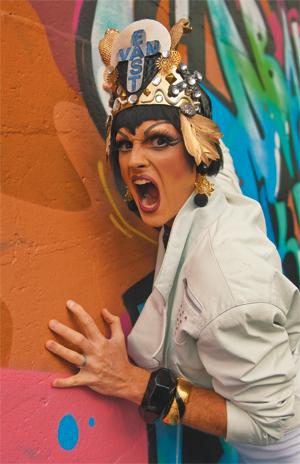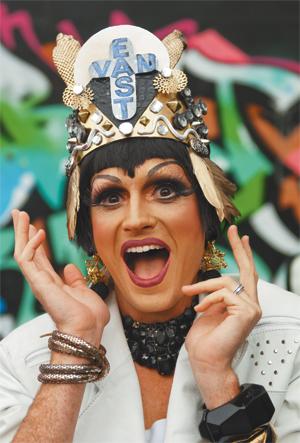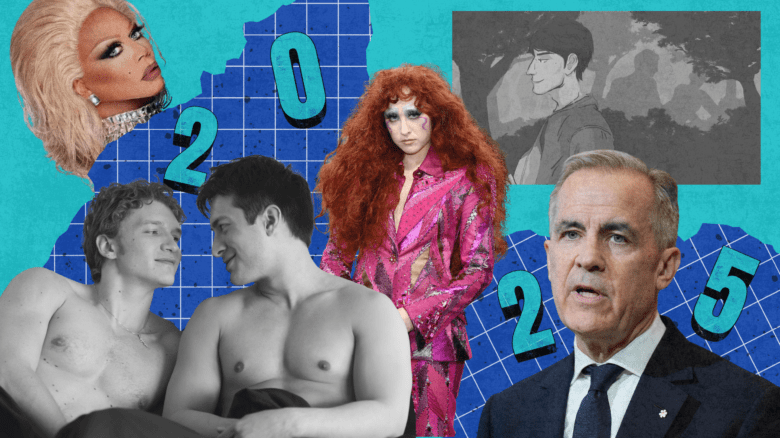
Isolde N Barron. Credit: Sergei Bachlakov
On stage and out of costume, four men rehearse at a notorious Main St bar.
They kick, strut and sashay as a Chicago number blares from the enormous speakers at The Cobalt.
It’s clear who their leader is: Cameron Mackenzie — Studio 58 alum, founder of Zee Zee Theatre, associate director of the Vancouver Playhouse’s La Cage Aux Folles and, perhaps most famously, the male alter ego of East Van drag royal Isolde N Barron.
In his declamatory South African tenor, Mackenzie loosely choreographs Apocalypstick co-founders Brandon Gaukel (the diabolical Bambibot Barron, now temporarily relocated to Toronto) and Dave Deveau (aka Peach Cobblah, prolific playwright, Cagelle dominatrix and Mackenzie’s fiancé).
Seasoned Eastside drag artist Kaylum Thornbury stands by, straight-faced and in character; his alter ego, Vera Way, concentrates on the improvised direction.
“I can’t do that,” Gaukel guffaws as Mackenzie demonstrates a series of showgirl kicks.
Mackenzie is undeterred.
The four men soon disperse: Gaukel to shave and Deveau to paint on Peach as they await the arrival of guests Jaylene Thyme and Kamelle Toe to continue rehearsals. It’s late August, and the first anniversary of East Van’s only weekly drag show is just days away.
Mackenzie initially had vague expectations for the show’s lifespan. “I don’t really think we thought about it to be quite honest,” he says on a Skype call from his cozy Coquitlam home. “If I’d stopped the show at three months, I would have been a flash in the pan. A year is long enough that I’m serious about it. That it actually had a life.”
With Apocalypstick, Isolde N Barron brings the drag traditions of Vancouver’s Downtown Eastside back to an audience generally too young to remember there ever being queer life outside the West End.
Though somewhat reminiscent of Ms T’s drag shows from the 1970s, Mackenzie says Apocalypstick stems from an entirely different, unexpected tradition.
“I wanted to create a variety show, like the old Judy Garland show, but with drag queens,” says the self-proclaimed Queen of East Van.
“I didn’t want to create just another drag show; I wanted to create variance.”
Compared to the drag shows of the West End, Mackenzie sees East Van drag as “a little riskier. I think we can be a little uglier. We can be a little more artsy. And our audience will go along with us.”
“I find that East Van drag is more open to being ugly,” Thornbury agrees. “The audience at Apocalypstick will accept more. Some numbers that I do there, I would never attempt downtown — they wouldn’t go over as well. I don’t know if people would get them.”
“The audience downtown is showing up with an idea of drag already in mind,” Thornbury suggests, while “East Van is a bit more open to where drag could be — where it can go.”
Thornbury, who has performed for Eastside audiences for years as Vera Way, does not dispute Isolde N Barron’s claim to the East Van throne.
“I think she’s opened up drag, [providing] a venue for people who don’t necessarily do downtown drag,” he says, adding that she has also given “a new platform for East Van, opening it up to new areas, new people.”
“I get a thrill when I see a room full of people that otherwise wouldn’t be in the same room together,” Mackenzie says. “I like to see a cross-section of queers together — I’m very passionate about connecting different generations of gays and different echelons of queers.”
Mackenzie revels in the Eastside’s changing queer demographics even as he seeks to propel those changes forward. “We have a wonderful cross-section of older people, younger people, varied genders and certainly varied sexualities. We have quite a few straight people that come and love the show. The whole show couldn’t even happen without our straight allies — the owners of The Cobalt,” he notes. “They’re incredibly supportive.”
He describes his relationship with The Cobalt’s owners and staff as “really lovely. They’re excited for the shows — they love what Isolde does just as much as my audience does. Far beyond the regular ‘we’re making money off the gays’ dynamic, they do things for our shows that they don’t necessarily benefit from.”
For fiancé and co-organizer Deveau, Apocalypstick is a “space for queers to gather and, specifically, for Isolde to engage her people.”
Since debuting his alter ego in 2007, Mackenzie has introduced her to every major Eastside queer event (from Bent to Odd Ball to Uncanny) and venue (from Lick to the Anza, and even the Biltmore). The demand for more Isolde N Barron is relentless, he says.
“We have 50 to 80 [people] a night on a Sunday — I think we are being recognized,” says Mackenzie, who is quick to share the credit with Deveau and Gaukel, without whom, he stresses, Apocalypstick would not exist.
“The audiences keep coming back, and the show keeps on growing. We have new faces all the time.”
Mackenzie’s performances as Isolde are bewitching. He is as much a magician as a drag queen. Audiences gush over his uncanny timing, hilarious gestures and stiletto-sharp wit. He cites Dame Shirley Bassey and Marlene Dietrich as influences, and in the part-classic, part-camp drag of Isolde N Barron, it shows.
“Dietrich herself was pretty damn camp. She was classic in her appearance. But her performances were sometimes quite funny and quite campy, and that’s a trait that Dietrich and I share quite closely,” he says, channelling Isolde’s aristocratic flair. “At the end of the day, we’re performers — and you get us on stage and we’re hams.”
“I’m a perfectionist,” the classically trained artist confides. “When I don’t do huge numbers every week, I feel like I’m cheating my audience sometimes — like I’m cheating myself as an artist.”
Fifty performances in at The Cobalt, Apocalypstick celebrated its first birthday with a packed house in early September.
Descending from a cramped dressing room that miraculously housed a tower of wigs and a half-dozen queens, Isolde N Barron and Peach Cobblah stepped on stage to host in matching outfits.
Bambibot’s opening number set the tone with deranged aplomb. Countless acts followed: Kamelle Toe as Dolly Parton; Vera Way with a pair of sock puppets; Peach Cobblah, first as Rihanna and later as pageant baby Eden Wood. The crowd roared continuously.
Finally, the show came to a close with the Chicago number.
In black and red, leather and lace — except Bambibot, who performed in virginal white and without a single manicured hair on his body — the queens brought the show to an explosive finish. The crowd screamed for more. For more Apocalypstick. For their East Van Queen.
Three months later, their enthusiasm has yet to wane.

 Why you can trust Xtra
Why you can trust Xtra


